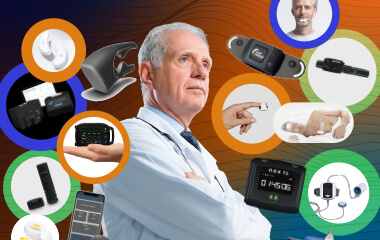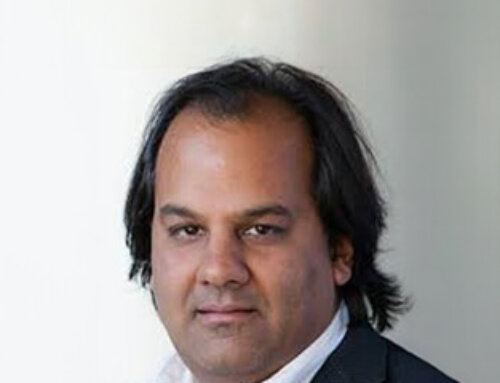The field of sleep medicine and the technologies that support sleep specialists continue to rapidly evolve. Newer technologies used for prescreening and diagnosing obstructive sleep apnea are not just smaller or more portable. They may use novel sensors, locations, processing, and artificial intelligence/machine learning/deep learning (AI/ML/DL) algorithms. The data outputs (such as respiratory events and sleep staging) often have been produced by technologies different from traditional polysomnographic sensors for data acquisition and scoring. This article is intended to help readers become more informed about newer obstructive sleep apnea diagnostic devices and their underlying novel technologies.
Consumer versus Clinical Technologies and the FDA
When evaluating new devices and technology, there are important distinctions to consider. First, devices can be classified as either clinical or consumer. Consumer devices can be purchased by the public and are not FDA cleared or approved. Many consumer devices may be FDA registered as wellness devices that are meant to promote a healthy lifestyle. Registered wellness devices are not FDA cleared or approved, and they are not intended to diagnose, cure, mitigate, prevent, or treat a disease or condition. Clinical devices generally require a prescription for use, data interpretation by a health care professional, and FDA clearance or approval for particular functions.
The FDA uses safety as a measure of whether a device requires clearance or approval. Most of the familiar diagnostic or therapeutic sleep technologies require (Class 2) FDA clearance. More invasive devices (such as implanted devices) generally require FDA approval, clinical trials, and rigorous evaluation to determine the risk-benefit ratio, including evaluation of clinical testing.
As a separate consideration, the FDA may clear a device or technology for a specific prescreening, diagnosis, or treatment purpose, or for a specific population. FDA (510K) diagnostic or therapeutic clearance indicates that the prescription device or technology in question has been deemed “substantially equivalent” to another device (e.g., to a predicate device) that previously has been FDA cleared or approved. Devices that do not have a predicate device may qualify for clearance through a De Novo pathway. Also note that software as a medical device (SaMD) may have FDA clearance, and that a non-FDA cleared device may use an FDA cleared SaMD. Additionally, inclusion and exclusion of populations, precautions, and clinical implementation should be considered whenever choosing a specific device or technology.
Novel Home Sleep Apnea Tests (HSATs)
Most of the novel devices can be grouped based on their operating mechanisms. See Table 1. Several HSAT systems, such as Sleep Profiler and Cerebra, have EOG/EMG/limited EEG to measure total sleep time(s) and to classify sleep stages. The Onera STS flow-based HSAT uses four patches on the head, chest, abdomen, and leg.
Beyond flow-based HSAT systems, most novel OSA-detecting wearables can be categorized into PPG-based or non-PPG-based. NightOwl and ANNE Sleep PAT derive peripheral arterial tonometry (PAT) signals from fingertip photoplethysmography (PPG). Belun Ring and SleepImage SaMD derive apnea-hypopnea index (AHI) using unique rings by obtaining PPG signals from the proximal phalanx of fingers.
Some non-PPG-based devices use proprietary acoustic sensors placed on the trachea (AcuPebble and BresoDX1). Others detect respiratory movements, with Sunrise measuring mandibular movements, and Wesper Lab using respiratory inductive plethysmography (RIP) on the chest and abdomen. Most non-PPG novel wearables have recently added fingertip PPG with pulse oximetry.
When considering any diagnostic technology, clinicians are encouraged to read the specific wording of the technology clearance on the Devices@FDA website.1
Special Considerations
In pediatrics, a key factor that affects the widespread use of these novel devices is the lack of validation data and clinical practice guidelines supporting its use, despite FDA clearance of some of these devices in children. With widespread use of novel technologies, the 2017 AASM position paper on pediatric OSA testing is currently being updated by the AASM.2
Clinicians also may want to familiarize themselves with March 2023 CMS changes regarding adult HSATs and coding, with special attention to revision history number R6.3 Per the update, all raw data must be reviewed and manually scored even if autoscored, and “all channels to and from the acquisition device must be physical channels and not derived, calculated, virtualized, or created by software to create channels for the purposes of the test and scoring of the raw data.”
FDA-Cleared “Prescreening Tests”
Unlike FDA clearance for OSA diagnostics or therapeutics, the definition, meaning, and use of technologies that are FDA cleared for OSA “prescreening/ home-screening” is unclear clinically. We are including discussion of OSA “prescreening” technologies as clinicians may be asked about these by patients. The FDA currently has cleared the Drowzle app, SleepCheck Rx app, and AcuPebble SA100 wearable for “prescreening/home-screening of adults suspected of OSA.” Despite the OSA “prescreening” clearance from the FDA for these technologies, we recommend that patients at risk for sleep apnea seek medical attention and be tested with FDA-cleared diagnostic tools rather than performing “prescreening” home tests.
Summary
In summary, the distinctions between consumer and clinical sleep technologies continue to evolve and affect how we advise patients and how these devices are used clinically. Individual practitioners and practices are strongly encouraged to consult with insurers regarding coding and billing for novel HSAT devices when used to diagnose OSA or to qualify for CPAP or other OSA treatments. Additionally, caution (when using a novel HSAT) is advised when the identification of central sleep apnea or other sleep disorders are a consideration or concern.
We also encourage sleep practitioners to visit the Devices@FDA website regarding FDA clearance/classification, clinicaltrials.gov to see individual device trials that are not yet published, and PubMed for peer-reviewed studies regarding individual devices. The AASM’s clinical resource, #SleepTechnology, is continuously updated with peer assessments of widely available devices.4
Lastly, given the number of consumer-based sleep technologies on the market, we encourage practitioners to consider the intended purpose, target population, and technology performance (validation) when discussing consumer apps or devices with patients.
Evin Jerkins, DO; Arvind Chandrakantan, MD; Ambrose Chiang, MD, FAASM; Makayla Cordoza PhD, RN, CCRN-K; Sumit Bhargava, MD; Ruchir Patel, MD; Sharon Schutte-Rodin, MD, DABSM, FAASM; Maryann Deak, MD, FAASM; Steven Holfinger, MD, MS; Julie Baughn, MD; Kelly G. Baron, PhD, MPH; Kevin Gipson, MD; Michael Grandner, PhD MTR; Jen N. Miller, PhD, APRN-NP; Dulip Ratnasoma, MD; Matthew Viereck, MD; Eric Yeh, MD; Anuja Bandyopadhyay, MBBS; Fariha Abbasi-Feinberg, MD, FAASM, on behalf of the AASM Emerging Technology Committee
This article appeared in volume eight, issue two of Montage magazine.
References
- U.S. Food and Drug Administration. Devices@FDA. https://www.accessdata.fda.gov/scripts/cdrh/devicesatfda/index.cfm. Updated July 3, 2023. Accessed July 5, 2023.
- Kirk V, Baughn J, D’Andrea L, et al. American Academy of Sleep Medicine position paper for the use of a home sleep apnea test for the diagnosis of OSA in children. J Clin Sleep Med. 2017;13(10):1199–1203. https://doi.org/10.5664/jcsm.6772
- Centers for Medicare & Medicaid Services. Billing and coding: polysomnography. https://www.cms.gov/medicare-coverage-database/view/article.aspx?articleid=56995&ver=14&. Revision effective date March 16, 2023. Accessed July 5, 2023.
- American Academy of Sleep Medicine. #SleepTechnology. https://aasm.org/consumer-clinical-sleep-technology/. Accessed July 5, 2023.
Table 1: Novel OSA Diagnostic Devices
| Characteristic | Diagnostic Device |
|---|---|
| FDA Cleared for Adult OSA Testing | ANNE Sleep, ARES, ApneaTrak, Cerebra, NightOwl, Nox T3s, Onera STS, *Sleepimage SaMD, Sleep Profiler PSG2, SOMNOtouch RESP, Sunrise, WatchPAT, Wesper Lab, Accusom, ZMachine synergy, BWMini HST, Belun ring (Belun Sleep Platform), BresoDX1, AcuPebble (SA100 for screening, OX100 for OSA diagnosis) |
| FDA Cleared for Pediatric Use (may not meet payor requirements; pediatric HSAT is not currently recommended by AASM) |
*Sleepimage SaMD (Age> 2), NoxT3s (Age > 2), WatchPAT (Age >12) |
| Collects and Reports SpO2 | ANNE Sleep, ApneaTrak, ARES, Cerebra, NightOwl, NoxT3s, Onera STS, ZMachine synergy, Belun Ring, Sunrise Sensor-2, AcuPebble OX100, BresoDX1, *SleepImage SaMD, BWMini HST, **Somfit |
| Includes EEG | ARES, ApneaTrak, Cerebra, Nox T3s, Onera STS, SOMNOtouch RESP, Sleep Profiler PSG2, BWMini, **Somfit, Z Machine Synergy |
| Ability to Score Raw Data | ANNE Sleep, ApneaTrak, ARES, Cerebra, NoxT3s, Onera STS, ZMachine synergy, NightOwl, *SleepImage SaMD, Sunrise, BWMini HST |
| Ability to Score or Report Central Events | ARES (with optional bluetooth respiratory effort belt), Z Machine Synergy; *SleepImage SaMD, BWMini HST |
| Multiple Night Use | ARES, NightOwl, Nox T3s, Sunrise, SOMNOtouch RESP, *Sleepimage SaMD, Sleep Profiler PSG2, Belun Ring, Z Machine Synergy |
| Novel Sensor Locations: | |
| Forehead | ARES, Cerebra, Onera STS, Sleep Profiler PSG2, **Somfit |
| Intraoral | **Achaemenid |
| Chin | Sunrise |
| Neck | Accupebble, BresoDX1 |
| Hand/Finger | NightOwl, *Sleepimage SaMD, WatchPAT, Belun Ring, ANNE Sleep |
| Chest/Abdomen | ApneaTrak, Cerebra, Nox T3s, Onera STS, SOMNOtouch RESP, Wesper Lab, WatchPAT One (with chest sensor) |
| Leg (limb leads) | Cerebra (optional), Onera STS |
*SaMD, software as a medical device. Only SaMD is FDA cleared for OSA testing, not the entire device.
**not FDA cleared









